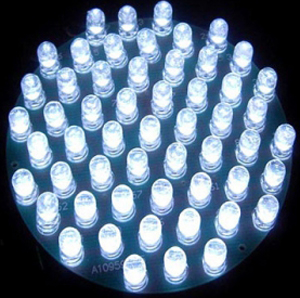Metal toxins in LED products
By David A Gabel
LED lighting is the newest, most efficient form of lighting to hit the markets.
It blows away even the most efficient compact fluorescent bulb, and is therefore, a much more expensive option.
However, the benefits to the environment from LED’s efficiency come with another environmental cost.
A new study from the University of California (UC) Irvine shows that LED bulbs contain lead, arsenic, and a dozen more potentially hazardous substances.
“LEDs are touted as the next generation of lighting. But as we try to find better products that do not deplete energy resources or contribute to global warming, we have to be vigilant about the toxicity hazards of those marketed as replacements,” said Oladele Ogunseitan, chair of UC Irvine’s Department of Population Health and Disease Prevention.
The researchers found that different LED bulbs contained different concentrations of toxins. For example, red bulbs, which can be found in vehicle brake lights or traffic lights, contain eight times more lead than what is allowed under California law.
White bulbs had less lead, but contained more nickel. In general, higher intensity, bright bulbs had more toxic contaminants than lower intensity bulbs.
Many of the contaminants found in the LED bulbs have been showed to adversely affect human health. Toxins like lead and arsenic are linked to various cancers, brain damage, hypertension, skin rashes, and other illnesses. The copper in LED bulbs, once released, can affect rivers, lakes, and infect fish.
If a bulb was to break, and somebody breathed in the fumes released, it would not automatically trigger cancer. However, it could act as a tipping point on top of exposures to other carcinogens. Plus, because lead tastes sweet, it is possible that children may mistake small ornamental LED lights as candy.
Under today’s law, LEDs are disposed of in typical landfills and are not classified as toxic, but the researchers are hoping that their study will change that. They believe that consumers should be aware of the potential harm from LED contaminants.
Measures that could be put in place may be to wear personal safety protection when cleaning up a broken LED bulb, whether at home, or with a cleanup crew at a traffic accident.
The problem, they say, is that there was insufficient product testing before LED bulbs came onto the market. There was a law that was supposed to take effect on Jan. 1 that would have mandated such testing, but it was opposed and blocked by industry groups, and has been put on hold.
The researchers believe that LED manufacturers can easily reduce the amounts of toxic chemicals in the bulbs by redesigning with safer materials.
“I’m frustrated, but the work continues,” said Ogunseitan. “Every day we don’t have a law that says you cannot replace an unsafe product with another unsafe product, we’re putting people’s lives at risk. And it’s a preventable risk.”
Link to published article: http://pubs.acs.org/doi/abs/10.1021/es101052q

























